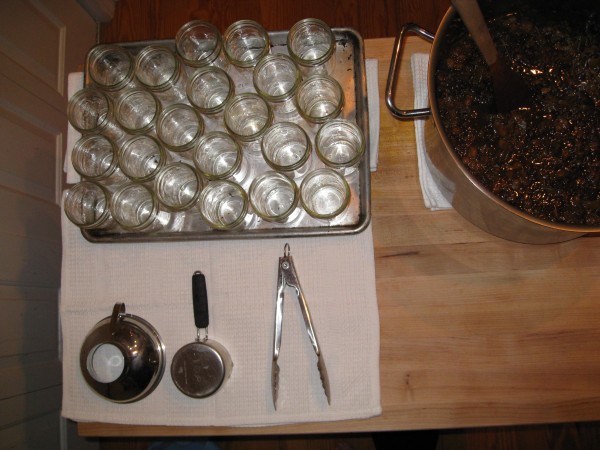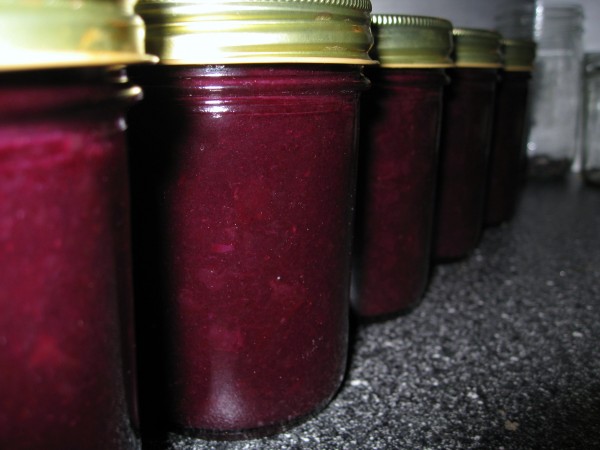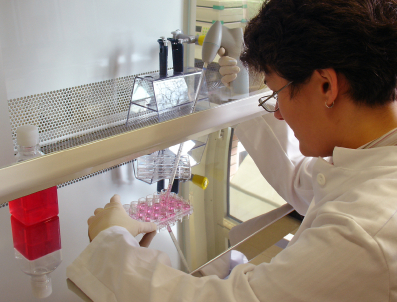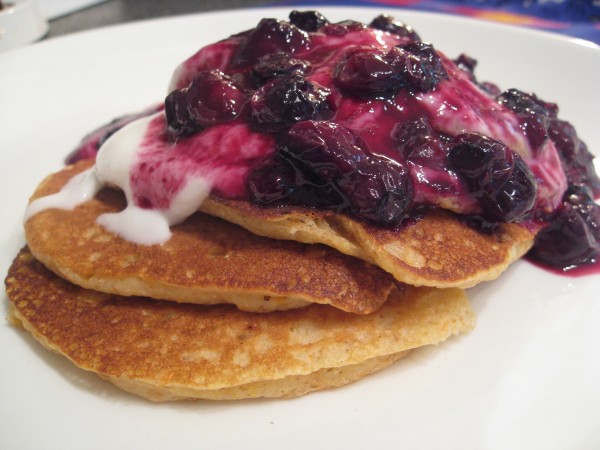As we approach the summer solstice, long, hot days spur a growth frenzy in the garden. That explosion of fertility produces the excesses that I live for. I love being swamped by 100 pounds of the fragile soft fruits of summer. It is a race against time. I must work quickly in order to get the fruit processed while it is at its prime. There is no satisfaction quite like turning the problem of too large a harvest, bound for the compost heap, into a prized condiment that will brighten the rest of the year.
 Have you pancakes and eat them too.Photo: April McGregerAs the harvest comes rolling in, I can never resist picking and buying more than I need. It overwhelms me, but I crave that feeling. By necessity all other demands fall by the wayside. The task of preserving consumes me. My normal mode of constant multi-tasking is relented, and I submit my full concentration to a day of putting up glistening jars of preserves. When I collapse into bed around the midnight hour after a long day of preserving, the ping of jar lids signifies a good seal and a rewarding day of work.
Have you pancakes and eat them too.Photo: April McGregerAs the harvest comes rolling in, I can never resist picking and buying more than I need. It overwhelms me, but I crave that feeling. By necessity all other demands fall by the wayside. The task of preserving consumes me. My normal mode of constant multi-tasking is relented, and I submit my full concentration to a day of putting up glistening jars of preserves. When I collapse into bed around the midnight hour after a long day of preserving, the ping of jar lids signifies a good seal and a rewarding day of work.
My first epic preserving battle of the season was with strawberries. Innocent enough in these parts, strawberries come in all alone with no other fruit with which to share the limelight. Then they are asked to step aside as the first round of early blueberries comes rolling in. Right on their heels are the first blackberries and raspberries, cling peaches, and sweet and sour cherries. The preserving marathon has begun. These next few months will be all about fruit preservation for me. It was my love affair with perfect summer fruit that inspired me to start my business making pickles and preserves, and this is prime time.
Long before I put up my first mason jars, preserving food was a necessity. Before World War II, wintertime tables showed evidence of summertime’s accomplishments, or lack thereof. Women and their daughters crowded together on back porches peeling peaches and apples, snapping beans, and shucking corn, and then around steaming kettles in the suffocating heat of late summer. It was exhausting, strenuous work necessary for their family’s subsistence, done in volumes rarely seen outside of commercial kitchens today.
Today we are experiencing a preserving renaissance. As more and more people desire to know where their food comes from and exactly what is in it, our human instincts towards preservation are reawakened. We are realizing the detrimental environmental effects of non-sustainable food systems, and we seek to build a whole and healthy alternative. Some have mastered eating locally grown food in the summer months and want to prepare for doing so through the winter as well. Perhaps you have been given a jar of homemade jam and you realize that preserving your own just tastes better.
 Can you top this?Photo: April McGregerThis is your year. Don’t let another season of harvests pass you by and send you into a long winter with a barren pantry. Grab a friend and head to the kitchen. You’ll need only a few simple tools and tips to make your preserving efforts successful.
Can you top this?Photo: April McGregerThis is your year. Don’t let another season of harvests pass you by and send you into a long winter with a barren pantry. Grab a friend and head to the kitchen. You’ll need only a few simple tools and tips to make your preserving efforts successful.
I am well aware that many experienced cooks and gardeners have an unfounded fear of preserving. I am here to tell you that you are not going to poison anyone. Other than the splatter of boiling sugar and occasional mold which can form on the top of a jar, fruit preserving is trouble free and simple. The problems associated with canning mostly involve low acid vegetables like green beans, which we will leave for the advanced class.
Before beginning your first canning and preserving efforts, it is a good idea to familiarize yourself with the basics of home canning. Next, you will want to assemble a few tools. Hardware stores are generally great places to find canning supplies, or you can mail-order a beginning canning kit. As you start your canning journey, be flexible. If your recipe for blueberry preserves is a softer set than you had hoped for, change your expectations. If you think of it more as blueberry sauce or compote, you might find it glorious in its own right.
I offer to you recipes for both a sweet and a savory blueberry preserve, which I feel is a good recipe for the beginner, and delicious enough that experienced preservers will return to it again and again. You can substitute blackberries, raspberries, or other bramble berries with similar results. Strawberries are very low in pectin and present a little bit more of a challenge. I prefer not to add artificial pectin to my preserves because I like the more intense flavor and natural texture of old-fashioned, concentrated fruit preserves. Try it this way, and I think you’ll like it. If you prefer a firmer set, you can add a whole grated apple, peel and all, to your berry preserves without sacrificing flavor.
Blueberry-Lemon Verbena Preserves
These chunky blueberry preserves reign supreme over pectin-pumped blueberry jam. Fully ripened fruit contains less pectin, so when making preserves, I like to use one-fourth just underripe fruit. I also love to throw in a few of my favorite herbs from my backyard, but you can leave them out if you prefer. Put some of these preserves away now, and you’ll no longer relegate your jam to peanut butter sandwiches, but will instead be spooning it over everything from crepes to yogurt to rice pudding and ice cream, and my favorite, cornmeal pancakes for the perfect breakfast.
 We be jammin’.Photo: April McGreger8 cups blueberries (2 quarts)
We be jammin’.Photo: April McGreger8 cups blueberries (2 quarts)
4 cups sugar
2 Tablespoons fresh lemon juice
A handful of lemon verbena leaves, torn into bite size pieces (optional)
Pick over the blueberries to remove any leaves, stems, or twigs. Rinse the berries, drain well, and place in a wide, large, heavy bottomed pot with the sugar and lemon juice and toss.
Place 2 small plates in the freezer. Bring the berries and sugar to a boil over high heat, stirring gently to dissolve the sugar. Bring to a hard boil and boil for 10 minutes until the juice has thickened. Watch it closely. Scrape the bottom of the pan often towards the end to be sure the preserves are not sticking, but be gentle with the berries. Add a dab of butter to the preserves to reduce foaming if necessary and skim carefully to remove any excess foam.
The syrup should reach 221 degrees in order to gel properly, or you can use the plate test to check the set. Check the set of the preserves by removing a plate from the freezer and dropping a spoonful of preserves liquid on it. Return it to the freezer for 2 minutes, then gently nudge the edge of the syrup with your finger. It should crinkle. If the preserves are too thin, return to a boil for 2 more minutes, then check again.
When the preserves pass the crinkle test, toss in the lemon verbena leaves and simmer for another minute.
Ladle very hot preserves into very hot, sterilized jars and top with hot sterilized two-piece lids.
You can sterilize your jars and lids in a steadily simmering hot water bath for 10 minutes or in a 275 degree oven for 15 minutes.
When the preserves are jarred, set aside and do not disturb for 24 hours. When completely cool, check the lids to see that they sealed properly by pressing the button on the top of the jar. If the button pops back, store the preserves in the refrigerator to prevent spoilage.
Makes about 5 half-pints.
Variation: Spiced Blueberry Chutney
This blueberry chutney is simply preserves nudged in the savory direction by sautéed shallots, a spot of red wine vinegar, and a little spice. It pairs very well with camembert-type cheeses, goat cheese, wild game, roasted duck, pork, and pate. It also makes a lovely replacement for cranberry sauce with roast turkey at Thanksgiving, so make a point to put some aside now.
Decrease the sugar to 2 cups.
Before bringing the blueberries and sugar to a boil, first sauté ½ cup chopped shallots and 1 Tablespoon grated fresh ginger in 2 Tablespoons olive oil.
After the sugar is dissolved and the preserves are boiling, add ¼ cup red wine vinegar, ½ teaspoon of fresh ground white pepper, 1 bay leaf, and a pinch each of freshly ground nutmeg and ground allspice.
Cook until thick, about 10 minutes. Check the set using the plate test.
Ladle the preserves into sterilized 8 oz. jars, top with sterilized lids and process in a boiling water bath for 7 minutes.
Buttermilk Cornmeal Pancakes
The perfect vehicle for a shimmering spoonful of blueberry preserves. Yum!
¼ cup stone ground cornmeal
½ cup all purpose flour
½ teaspoon salt
1 teaspoon baking soda
1 egg
1 cup buttermilk
2 Tablespoons melted butter, unsalted
In a medium mixing bowl, combine the dry ingredients – cornmeal, flour, baking soda, and salt – with a whisk. In another medium bowl, whisk together the egg, buttermilk, and melted butter.
Whisk the dry ingredients into the wet ingredient until just combined. Some small lumps are okay. Be careful not to over mix.
Heat a heavy bottomed skillet or griddle over medium heat. Grease the pan lightly with butter. Spoon the pancake batter into the hot skillet, using about 2-3 tablespoons per pancake. Cook on one side until bubbles appear on the surface of the pancake and flip. Cook the pancakes another minute on the other side. Place on a plate in a warm oven to hold warm until all the pancakes are cooked.




